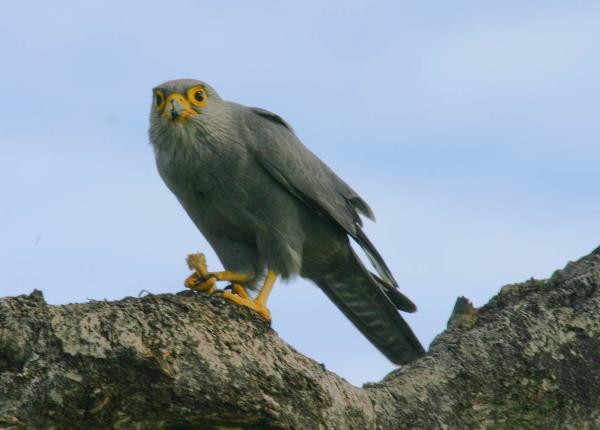How The Peregrine Fund is Helping
Though The Peregrine Fund does not work directly with Gray Kestrels, our efforts in scientific research, habitat conservation, education, and community development help conserve birds of prey around the world. We also supply literature to researchers from our avian research library, which helps scientists around the world gather and share important information on raptor conservation. And, finally, our support of the Global Raptor Information Network gives raptor researchers tools to more efficiently conduct their own studies while contributing to a global program. It also provides citizen scientists a way to participate in raptor science and conservation.
Where They Live
The Gray Kestrel is found throughout a large area within sub-Saharan Africa. It makes its home in moist palm savanna and woodland areas, as well as in openings in secondary and primary forest. If you are ever in Gray Kestrel territory, also look for it foraging over cultivated areas and near open and burned grasslands.
What They Do
True to its name, the Gray Kestrel is, well, gray. Though it might sound a bit dull, this bird is actually quite stunning. Apart from the slate-gray feathers that adorn its head, belly, back and wings, it has bright yellow legs, cere, and eye ring. Its tail and wings, in particular, are also marked with black and white barring.
This kestrel spends quite a bit of its time perched on telephone and electricity lines, or in tall snags. These make great vantage points from which to search the ground for prey. Though this bird usually spends most of its time alone, it can sometimes be found in larger flocks, especially when there is a feast to be had - such at a large termite swarm.
Why They Need Our Help
The Gray Kestrel is categorized as a species of Least Concern, which means that conservationists aren't too worried about this species' population into the foreseeable future. While it is considered uncommon throughout its range, some evidence suggests that as humans cleared forests for agricultural purposes they may have actually benefited this species, by providing it with additional hunting habitat. However, in the southern portion of its breeding range, many of the palm trees these kestrels use for nesting are being cut down and this will certainly have an affect on its population numbers in the future.
What They Eat
This kestrel, like many other kestrel species, feeds primarily on rodents, small birds, bats, small reptiles, frogs, insects, and other invertebrates. With such a wide variety of animals it will take, it has developed a few different hunting techniques. It might swoop up prey from the ground or low brush, after a dive from an exposed perch. It might also capture its prey after a speedy aerial pursuit. These kestrels will sometimes flock together in small groups to trap swarming termites, whether in the air or on the ground.
Nests, Eggs, and Young
Like most kestrels, this species doesn't build its own nest. It might nest in holes in trees, or, more commonly, it chooses to lay its eggs in the cavities of large stick nests built by Hammerkops, which are medium-sized wading birds. Females will lay 2-5 eggs, which are oval-shaped, and densely spotted with brick-red, orange-brown, umber, and lilac-gray flecks. Like with most other falcons, the female does most of the care and incubating of the eggs while the male is in charge of hunting and bringing back enough food to feed himself, the female, and upon hatching, the nestlings.
Gray Kestrel and the World Center for Birds of Prey
Though The World Center for Birds of Prey is quite far from the Gray Kestrel's range, it is still a wonderful place to learn about birds of prey, and even other kestrel species! Come to the World Center for Birds of Prey and meet an American Kestrel up close, examine kestrel feathers at the touch table, and compare the size of a kestrel egg with that of an ostrich. If you walk the interpretive nature trail to the gazebo overlooking the Boise Valley, you are likely to see a kestrel hovering over the sage in search of prey or, if you are lucky, a young bird just learning to fly.
References:
BirdLife International. 2016. Falco ardosiaceus. The IUCN Red List of Threatened Species 2016: e.T22696406A93560247. https://dx.doi.org/10.2305/IUCN.UK.2016-3.RLTS.T22696406A93560247.en. Downloaded on 29 November 2021.
Global Raptor Information Network. 2021. Species account: Grey Kestrel Falco ardosiaceus. Downloaded from http://www.globalraptors.org on 29 Nov. 2021
Kemp, A. C., G. M. Kirwan, and A. Bonan (2020). Gray Kestrel (Falco ardosiaceus), version 1.0. In Birds of the World (J. del Hoyo, A. Elliott, J. Sargatal, D. A. Christie, and E. de Juana, Editors). Cornell Lab of Ornithology, Ithaca, NY, USA. https://doi.org/10.2173/bow.grykes1.01









